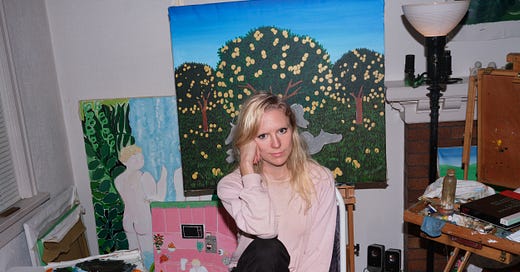An Interview with Claire Milbrath
Illustration is often a dirty word in the art world. It’s association with childhood and narrative creates a pejorative, spat like a spray of kool-aid directed at a canvas. But it doesn’t have to be that way. The recent red-hot trend of figurative painting shows the potential of illustration. With tableaus that suggest and tell, the viewer wonders: who are these characters, how did they get in that situation? The fact that a painting can pack such a literary punch is thrilling.
Claire Milbrath’s paints a very illicit, and very grown-up, picture book. The mundane is captured in swift strokes and bold colours. World building par excellence. The subject matter—which can be compared to literary fiction where each day the character takes part in the banality life, interjected with the odd moment of climax—is at odds with the surreal setting. Maybe life would be much better lived amongst Claire’s bright palette and 80s decor. I consider Claire an art world auteur.
Keep reading to find out WHO IS GRAY?
TD: What was the genesis of Gray? Can you tell us a story about him?
CM: When I was younger Gray was the lead character of my comic strip. He was anxious, trapped in the limited world I illustrated for him. As I grew up, I increasingly used Gray to project my complicated feelings onto - anxiety, loneliness, sexuality. Now Gray is my alter-ego, along with his bichon companion, I use the two characters to process my personal life. I identified as sickly when I was younger, and Gray reflected that. I’ve tried to give him more joy and health in the past few years, he’s more active and has the love of a loyal companion. The hope is that these traits will be reflected in my real life.
TD: What's the relationship between your paintings and sex? Do you consider them erotic extensions? Or simply humorous?
CM: My paintings are a way for me to express intimacy and desire. When I look at my past erotic bathroom scenes, I remember painting those with a yearning, desperate heart, wanting a partner, and that kind of domestic, submissive, perverted, loving, intimacy. Darby says they are aspirational scenes.
Though currently, I’m working on a show with some erotic scenes in it, that feels less like aspirations, and more a way for me to process fucked up feelings around sex, worship, romance.
TD: I know you've mentioned being inspired by naive artists such as Maude Lewis and Henry Rousseau—how do you tap into a style of naivete as you progress technically as an artist?
CM: I am a stubborn old woman with my practice, so I’ve resisted progressing technically. I want to preserve my “wrongness.” The Naive paintings are unpretentious, like here is a story I want to show you, and this is the most efficient way I can present it to you visually. I am an efficient painter too, I cut corners. I paint the face first, then the foreground, then the background lasts. My work is rooted in narrative and drawing. The painting is fast, but I usually make about 10 sketches on paper first. Every once in a while I experiment with the paint, with a cloud or a landscape, I can get a little freer. My progression in painting has been on a personal level, realizing how closed off I was with past work, not wanting to share myself. I'm painting real events and scenes from my life now. My last show at Pangée felt like I was sharing my diary. It was emotional to see the work hung, the painted tulips Darby sent me when I was sad. I hope that people can find aspects to relate to. I use painting as a way to connect to others because in real life I’m quiet and hermit-like.
TD: How does running Editorial Magazine influence your paintings? Are you ever hyperaware of how your work might be perceived?
CM: No thankfully. My painting feels separate from Editorial. Editorial Magazine is my job and painting is my joy. This last year, I treated myself to painting more and put the magazine on the back-burner. I hope no one noticed too much. I do get inspiration from interviewing or writing about other artists, I love finding out what artists are into it, the rabbit hole effect.
TD: What's next for you after your show at Projet Pangée?
CM: I’m working on a solo show at Los Angeles’ DeBoer Gallery. I’m excited about this body of work. A break-up and a loved one’s drug addiction had me on my knees this year, so I felt grateful for the task of painting. Most of my shows are about love, men, intimacy. This show is about God, and I found painting helped me connect with my higher power.
Claire Milbrath (b. 1989 Victoria, Canada) is a self-taught artist working with painting, sewing, and drawing. Adopting an artistic style reminiscent of naive painters, Milbrath incorporates large swaths of lush color to construct her compositional space, renewing the coloristic tradition with vignettes relating to unrequited love, sexual fantasies and childhood innocence. She is the founding publisher and editor-in-chief of Editorial Magazine, a print journal on contemporary art.
UPCOMING EVENT: As part of our collaboration with Young Collector’s League, we will be visiting Heather Goodchild’s studio this Saturday 18th at 1pm. $10 gets you in the door and access to wine and snacks. RSVP here.
WATCH an interview with Hangama Amiri, as part of the Studio Visits series with ART + PUBLIC UnLtd.











